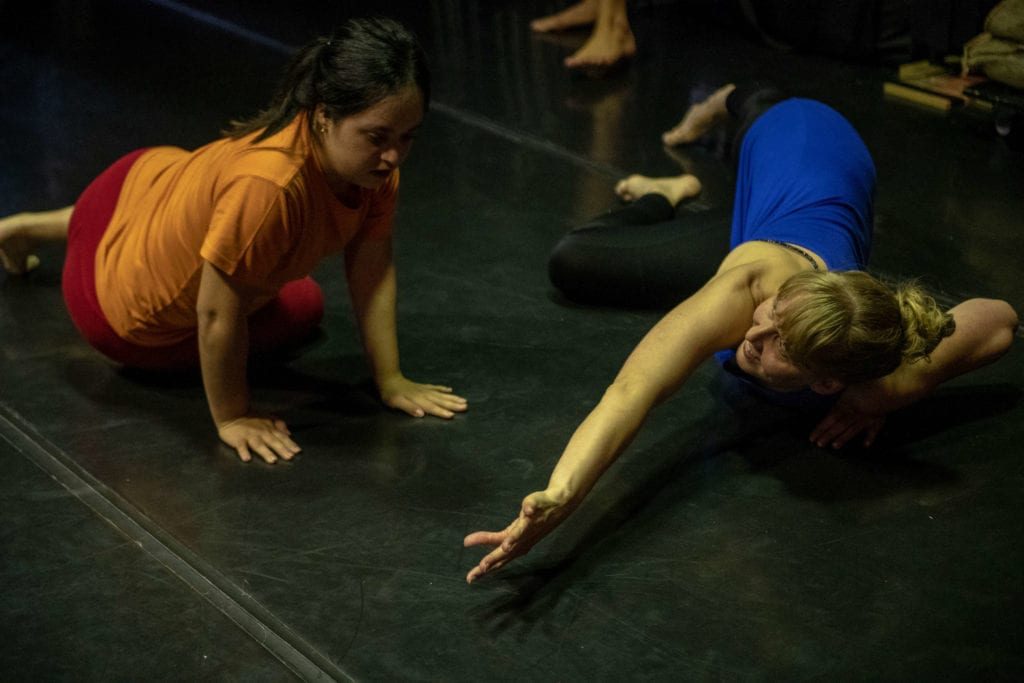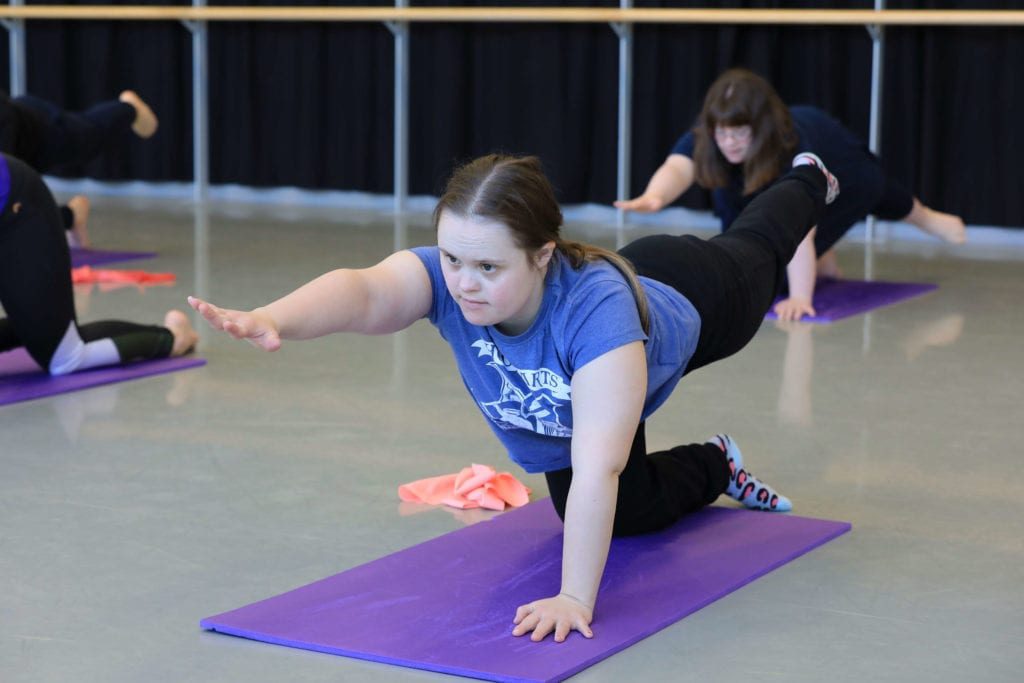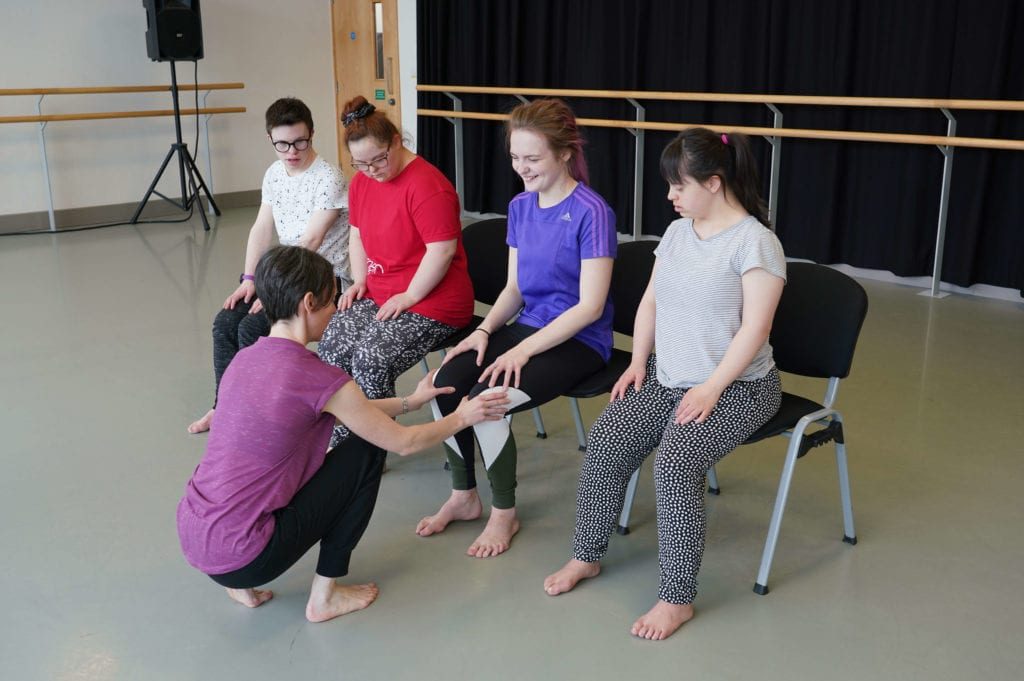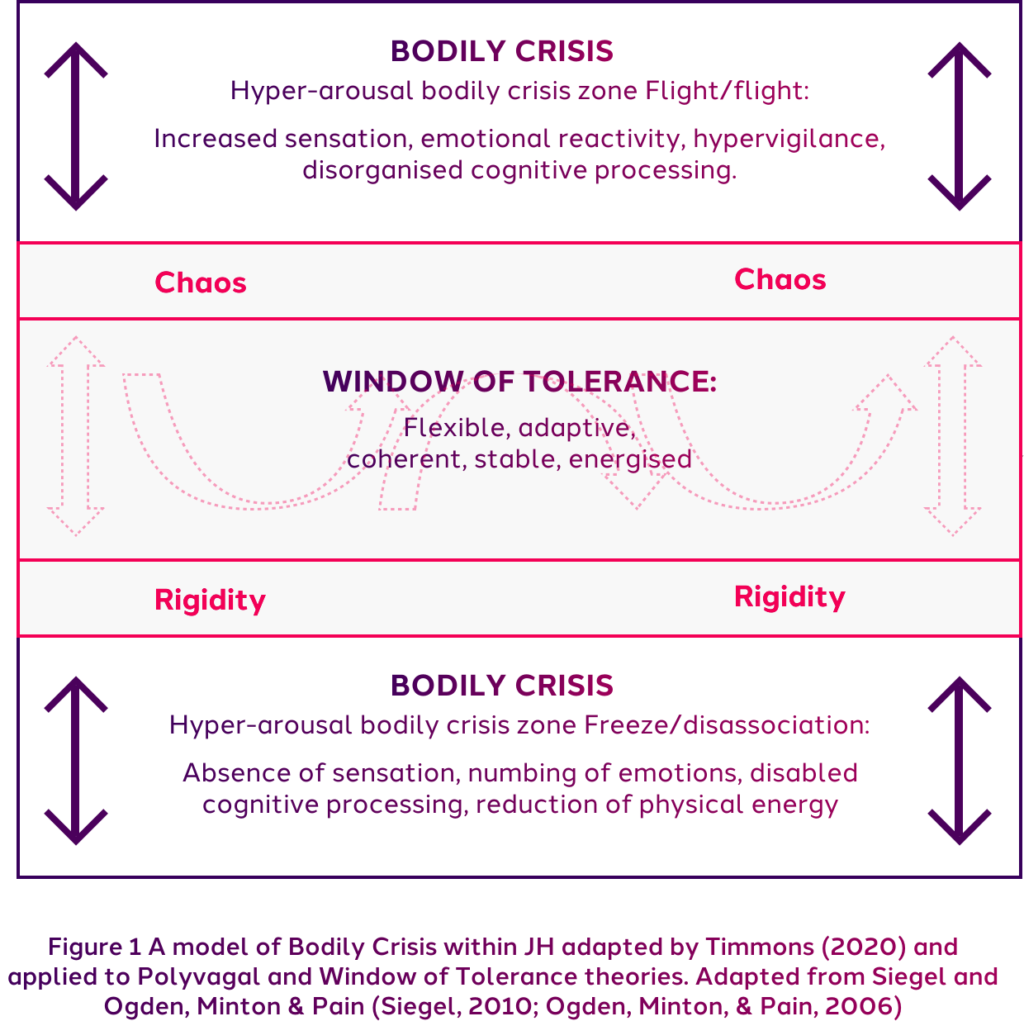The interrelationship between Down syndrome, Autism spectrum disorder and Joint hypermobility within the dance teaching and learning environment.
What is Joint hypermobility?
Joint hypermobility is a spectrum of disorders that affects the suppleness of joints making them unusually flexible and is often referred to as double-jointedness. This can occur in several joints throughout the whole body (known as generalised joint hypermobility, GJH), mainly the fingers (peripheral joint hypermobility, PJH) and whilst it can present in a young developing body it may also decrease with age and natural maturation of the musculoskeletal system as the body naturally stiffens up (historical joint hypermobility, HJH). Joint hypermobility is also linked with more severe conditions that require specialist diagnostic tools such as Marfan syndrome (MFS), Osteogenesis Imperfecta (OI) and Ehlers-Danlos syndromes (Castori et al., 2017).
Is Joint hypermobility associated with Down syndrome and Autism spectrum disorders?
Currently there is evidence to suggest that there are also links between JH and Down syndrome (DS) and Autism spectrum disorders (ASD) (Foley & Killeen, 2019; Talbot & Alshryda, 2017). Difficulties that connect Down syndrome (DS) with JH present as ,for example, total or partial dislocations of the hip and or knee cap (Talbot & Alshryda, 2017) and a combination of ligaments that lack tensile properties and muscles with low tone (Foley & Killeen, 2019). These complications are secondary in DS and are therefore often missed and infrequently reported (Foley & Killeen, 2019). These associations can however contribute to increased health risk of injury and a number of musculoskeletal complications that can potentially lead to delayed motor skills and milestones (Przymuszała et al., 2018). Similarly and whilst commonly only linked with stereotyped behaviours (such as social and communication problems along with other behavioural issues), ASD also occurs alongside the physical complications that are common in JH.
These include the delay in gross motor and fine motor milestones, hypotonia (soft muscle tone) and increased joint laxity (Anujot, Devi, & Swati, 2019). This is not however always flagged up in the literature because each condition (DS, ASD & JH) has very separate blanket terms that describe the underpinning origins and seemingly clinically unrelated pathologies that usually appear with these disorders in childhood. In such, DS, ASD & JH are also typically seen by different medical fields and doctors, such as psychiatry in the case of ASD, specialist doctors for genetics and delayed intellectual development for DS and musculoskeletal disciplines and rheumatology in the case of JH related disorders. Thus, links between these pathologies are rarely established in clinical settings.
How does Joint hypermobility present in learning disorders, Down syndrome and Autism spectrum disorders?
Evidence of links between JH and altered brain development and activity in children such as attention deficit disorders ADD, attention deficit hyperactivity disorders ADHD, Autism spectrum disorders ASD, clumsiness, poor coordination, proprioception and visio-spatial skills are increasingly presented as potential mechanisms through which JH and psychopathological symptoms are linked (Sinibaldi, Ursini, & Castori, 2015). The need for research in this emerging area was recently highlighted so that a better understanding of the somatic and developmental/psychiatric aspects of JH is made (Baeza-Velasco, Grahame, & Bravo, 2017). Links between JH and ASD are indeed beginning to appear in the literature and there is currently a growing body of research that suggests that ASD and JH can co-occur and that the likelihood of this happening is more often than projected (Baeza Velasco, Hamonet, Baghdadli, & Brissot, 2016; Eccles, Owens, Mathias, Umeda, & Critchley, 2015). Similarly JH is now becoming a more frequently discussed phenomenon with regards to DS however the current assessment for JH (e.g. Beighton scoring) fails to identify the hypermobile joints and the severity of hypermobility characteristics that are specific within DS (Foley & Killeen, 2019).
For the purpose of teaching dance in inclusive situations, it is clearly important then for teachers to have an awareness of and understand the physical and psychosocial implications of JH as well as understanding DS and ADS.
Joint hypermobility within the dance studio
The implications of Joint hypermobility are better understood from a bio-psycho-social perspective which is further explained here



Bio-markers of Joint hypermobility that are related to dance
At a biological or physical level JH enables extreme range of motion in the joints and appears as hyperextension in the knees and elbows. It is often characterised in lay terms as ‘double-jointedness’ and those who have JH are also often described as having ‘bendy bodies’. These characteristics are also very conducive to the physical demands and aesthetic that is desired within dance and some aesthetic sports. Not surprisingly then, JH is reported to be prevalent within dancers and commonly signposted as a ‘potential asset’ in vocational dance settings (Mccormack, Briggs, Hakim, Grahame, & Grahame, 2004; Scheper et al., 2013).
In addition to the excessive flexibility that is available in JH, teachers of dance need to also be aware of the less apparent signs and symptoms of JH. Joint hypermobility may also exist as a symptomless feature and asset to any dancers (Castori et al., 2017). However, the unwarranted use of the excessive flexibility within an inherently fragile hypermobile joint can lead to micro and macro trauma. Micro trauma is for example a silent recurring injury that is often not detected by the clinician or individual at the time it occurs (Castori et al., 2017). With overuse and repetitive movement, which is often inevitable for example in dance, this may lead eventually to pain, chronic pain, and bone degeneration. When specific, for example to the hip joint, labral tears (this is a tear to the cartilage that is attached to the rim of the hip socket that helps keep the head of the femur in place) can occur (Devitt, Smith, Stapf, Tacey, & O’Donnell, 2017). Similarly, macro traumas are for example dislocations, tendon ruptures and soft tissue injury, that occur due to instability and/or weakness of the joint, fragility of the connective tissue and also as a result of the type of overuse of excessive flexibility that is often seen in dance (Castori et al., 2017).
Poor proprioception (sense of the body in space/body awareness) is also commonly associated with JH (Chopra et al., 2017; Fatoye, Palmer, Macmillan, Rowe, & van der Linden, 2009; Ghibellini, Brancati, & Castori, 2015; Nagai, Schilaty, Strauss, Crowley, & Hewett, 2018) and proprioception may also be further diminished as a result of the type of micro trauma discussed above. Reduced proprioception and muscle strength are of course interrelated, the one affecting the other in a vicious circle. Unfortunately this in turn limits the very activities that are recommended for rehabilitation, strengthening and return to healthy functioning in joints (Scheper et al., 2013, 2016). Diminished proprioception may also be the cause of the apparent clumsiness that has in the past been anecdotally associated in children with JH and more so in the literature over the past decade (Ghibellini et al., 2015). Indeed clumsiness or delay in walking for example is often a silent sign to the existence of JH (Adib, Davies, Grahame, Woo, & Murray, 2005; Ghibellini et al., 2015) and may then potentially also be a sign for ASD. This has however yet to be substantiated in the literature. Clumsiness is often a warning sign to parents and paediatric practitioners that something may not be quite right and it is also often the motive for them to prescribe gentle and controlled physical activities (such as dance) as a means to improve coordination and walking. As dance is often recommended in these situations, it is clearly important that dance teachers are able to recognise not only of the clumsiness but also the potential underlying condition of JH.
Another feature that regularly features with JH is the apparent rapid tiring and deconditioning of the body (Keer & Grahame, 2003). It is also then important for dance teachers to understand and compensate for unexplained tiredness in class using with a little and often approach when compensating for the poor condition when returning to class after a period of rest such as a holiday.
Psychosocial markers of Joint hypermobility that are also relevant to dance
Whilst it is established that JH is often apparent in dancers because of the associated flexibility (Armstrong & Greig, 2018; Chan, Hopper, Zhang, Pacey, & Nicholson, 2018; McCormack et al., 2004) there are also psychosocial aspects of JH that make it potentially less favourable to dance training and performance. These are again things that dance teachers should be aware of and understand, for example, JH has more recently been unexpectedly associated with increased anxiety (Bulbena-Cabré et al., 2018). This has since been further investigated from a psychosocial perspective and JH is increasingly becoming also connected with poor body awareness and disorders that include anxiety, fear and dysautonomia (linked to the fight/flight mechanism of the autonomic nervous system (ANS) which can adversely affect the health and may affect the functioning of homeostasis, the heart, bladder, intestines, sweat glands, pupils, and blood vessels) (Baeza Velasco et al., 2016; Bulbena-Cabré et al., 2018). Unlike the biological characteristics of JH, these are clearly less favoured for training in dance and are therefore important for teachers to know and recognise. The implications of these conditions are further explained below.
Anxiety and bodily crisis in Joint hypermobility
Within ‘normal’ functioning and a balanced body awareness there is a threshold for example to anxiety or window of tolerance within which we all operate. Trauma or turbulence, potentially caused for example by poor or imbalanced body awareness and/or additional stressors such as a feeling of being overwhelmed and anxious can potentially result in a person with JH ‘flipping’ between and or getting temporarily stuck within either the hyper and hypo arousal states (Ogden, Minton, & Pain, 2006; Siegel, 2010). This is further explained using the polyvagal theory and the notion of our three defence mechanisms (fight, flight and dissociation) that are available when danger or turbulence is sensed (Porges, 2017, p. 101).

Creativity, emotional expression, learning and Joint hypermobility
Interestingly, the polyvagal theory (Heilman et al., 2008; Kemp, 2017; Porges, 2017) further proposes that when the body is in any one of these defence mechanisms it is using metabolic resources and cannot be for example be creative or heal. The implications for this within dance are therefore significant as creativity is fundamental to dance whilst injury is also prevalent within dance due the demands at a professional or vocational level. Porges (2017) further proposes that the “neural pathway for healing overlaps with the neural pathway for social engagement” (p.101) and is indeed the pathway that sends information between the brain and the body signalling safety and providing calm. This pathway, in addition to providing feelings of safety and calm, also enables social engagement and expression in the face and body (Porges, 2017, p.101-102). Again this is significant in dance as expression through the face and body is critical. Therefore the neural pathway for social engagement that Porges discusses, including the interchange of information between the brain and body, can potentially also include behaviours that are relevant to effective teaching and learning environments. For example, ‘feeling safe’ is a condition that is important in learning as a form of social engagement. Indeed a recent shift in thinking within learning theory and practice now recognises the important role of emotional well-being for learning alongside the more established theories of motivation (Rowe, Fitness, & Wood, 2015). It is now understood that intense emotions are associated with hypermobility (Eccles et al., 2015), and intense emotions can also invigorate the mechanism that influences the fight, flight and disassociation within JH. Intense emotions are however a catalyst for art and in such “fuel the dance-making process and ignite audiences” (Minton & Faber, 2016). Indeed good dance training involves the cultivation, manipulation and communication of emotions from a relatively young age. This then suggests that appropriate teaching awareness and understanding of these mechanisms may act as a protective factor for dancers with JH as it will inevitably enable a deeper understanding of feelings and emotions and hence unavoidably also to self-regulation.
These are some of the reasons it is important that all teachers of dance develop their awareness of and understand the bio-psycho-social implications of JH as it is unavoidably prevalent in dance settings. For teachers of dance in inclusive settings it is further important that they understand not only the complexities of working in an inclusive environment but also the potential interrelatedness of for example, DS, ASD and JH.
This section is based on research included in the PhD thesis submitted by Wendy Timmons who is programme director for the MSc Dance Science & Education at the University of Edinburgh. A more indepth version can be found here
Bibliographic references & further reading
Adib, N., Davies, K., Grahame, R., Woo, P., & Murray, K. J. (2005). Joint hypermobility syndrome in childhood. A not so benign multisystem disorder? Rheumatology, 44(6), 744–750. https://doi.org/10.1093/rheumatology/keh557
Anujot, K., Devi, M., & Swati. (2019). Lowerlimb Joint Laxity in Children with Autism Affiliations. Our Heritage, (7), 315–324.
Armstrong, R., & Greig, D. M. (2018). The Beighton score as a predictor of Brighton criteria in sport and dance. Physical Therapy in Sport, 32, 145–154. https://doi.org/10.1016/j.ptsp.2018.04.016
Baeza-Velasco, C., Grahame, R., & Bravo, J. F. (2017). A connective tissue disorder may underlie ESSENCE problems in childhood. Research in Developmental Disabilities, 60, 232–242. https://doi.org/10.1016/j.ridd.2016.10.011
Baeza Velasco, C., Hamonet, C., Baghdadli, A., & Brissot, R. (2016). Autism Spectrum Disorders and Ehlers-Danlos Syndrome Hypermobility-Type : Similarities in clinical presentation. Cuadernos de Medicina Psicosomática y Psiquiatria de Enlace, ISSN 1695-4238, No. 118, 2016, Págs. 49-58, (118), 49–58.
Bulbena-Cabré, A., Rojo, C., Pailhez, G., Buron Maso, E., Martín-Lopez, L. M., & Bulbena, A. (2018). Joint hypermobility is also associated with anxiety disorders in the elderly population. International Journal of Geriatric Psychiatry, 33(1), e113–e119. https://doi.org/10.1002/gps.4733
Castori, M., Tinkle, B., Levy, H., Grahame, R., Malfait, F., & Hakim, A. (2017). A framework for the classification of joint hypermobility and related conditions. American Journal of Medical Genetics, Part C: Seminars in Medical Genetics, 175(1), 148–157. https://doi.org/10.1002/ajmg.c.31539
Chan, C., Hopper, L., Zhang, F., Pacey, V., & Nicholson, L. L. (2018). The prevalence of generalized and syndromic hypermobility in elite Australian dancers. Physical Therapy in Sport. https://doi.org/10.1016/j.ptsp.2018.02.001
Chopra, P., Tinkle, B., Hamonet, C., Brock, I., Gompel, A., Bulbena, A., & Francomano, C. (2017). Pain management in the Ehlers–Danlos syndromes. American Journal of Medical Genetics, Part C: Seminars in Medical Genetics, 175(1), 212–219. https://doi.org/10.1002/ajmg.c.31554
Devitt, B. M., Smith, B. N., Stapf, R., Tacey, M., & O’Donnell, J. M. (2017). Generalized joint hypermobility is predictive of hip capsular thickness. Orthopaedic Journal of Sports Medicine, 5(4), 1–7. https://doi.org/10.1177/2325967117701882
Eccles, J. A., Owens, A. P., Mathias, C. J., Umeda, S., & Critchley, H. D. (2015). Neurovisceral phenotypes in the expression of psychiatric symptoms. Frontiers in Neuroscience, 9(FEB), 1–13. https://doi.org/10.3389/fnins.2015.00004
Fatoye, F., Palmer, S., Macmillan, F., Rowe, P., & van der Linden, M. (2009). Proprioception and muscle torque deficits in children with hypermobility syndrome. Rheumatology, 48(2), 152–157. https://doi.org/10.1093/rheumatology/ken435
Foley, C., & Killeen, O. G. (2019). Musculoskeletal anomalies in children with Down syndrome: An observational study. Archives of Disease in Childhood, 104(5), 482–487. https://doi.org/10.1136/archdischild-2018-315751
Ghibellini, G., Brancati, F., & Castori, M. (2015). Neurodevelopmental attributes of joint hypermobility syndrome/Ehlers-Danlos syndrome, hypermobility type: Update and perspectives. American Journal of Medical Genetics, Part C: Seminars in Medical Genetics, 169(1), 107–116. https://doi.org/10.1002/ajmg.c.31424
Heilman, K. J., Bal, E., Bazhenova, O. V., Sorokin, Y., Perlman, S. B., Hanley, M. C., & Porges, S. W. (2008). Physiological responses to social and physical challenges in children: Quantifying mechanisms supporting social engagement and mobilization behaviors. Developmental Psychobiology, 50(2), 171–182. https://doi.org/10.1002/dev.20257
Keer, R., & Grahame, R. (2003). Hypermobility Syndrome (1st ed.; R. Keer, R. Grahame, Ed.). Butterworth & Heinemann.
Kemp, A. H. (2017). Editorial: Mechanisms underpinning the link between emotion, physical health, and longevity. Frontiers in Psychology, 8(AUG), 8–11. https://doi.org/10.3389/fpsyg.2017.01338
Mccormack, M., Briggs, J., Hakim, A., Grahame, R., Grahame, R. (2004). Joint laxity and the benign joint hypermobility syndrome in student and professional dancers, The Journal of Rheumatology, Downloaded March 2020
Minton, S., & Faber, R. (2016). Thinking with the Dancing Brain, Embobyin Neuroscience. Rowman & Littlefield, London.
Nagai, T., Schilaty, N. D., Strauss, J. D., Crowley, E. M., & Hewett, T. E. (2018). Analysis of Lower Extremity Proprioception for Anterior Cruciate Ligament Injury Prevention: Current Opinion. Sports Medicine, 48(6), 1303–1309. https://doi.org/10.1007/s40279-018-0889-1
Ogden, P., Minton, K., & Pain, C. (2006). Trauma and the body: A sensorimotor approach to psychotherapy. New York: Norton series on interpersonal neurobiology. New York, NY, US: W W Norton & Co.
Porges, S. W. (2017). The Pocket Guide to the Polyvagal Theory: The Transformative Power of Feeling Safe. W.W. Norton & Co Ltd London.
Przymuszała, A., Roszak, M., Kulik, O., Uździcki, A., Skrzypińska, A. T., Rotter, I., & Ptak, M. (2018). Generalised joint hypermobility as a symptom of chosen diseases and syndromes. 8(4), 246–255.
Rowe, A. D., Fitness, J., & Wood, L. N. (2015). University student and lecturer perceptions of positive emotions in learning. International Journal of Qualitative Studies in Education, 28(1), 1–20. https://doi.org/10.1080/09518398.2013.847506
Scheper, M. C., De vries, J. E., De vos, R., Verbunt, J., Nollet, F., & Engelbert, R. H. H. (2013). Generalized joint hypermobility in professional dancers: A sign of talent or vulnerability? Rheumatology (United Kingdom), 52(4), 651–658. https://doi.org/10.1093/rheumatology/kes220
Scheper, M. C., Juul-Kristensen, B., Rombaut, L., Rameckers, E. A., Verbunt, J., & Engelbert, R. H. (2016). Disability in Adolescents and Adults Diagnosed With Hypermobility-Related Disorders: A Meta-Analysis. Archives of Physical Medicine and Rehabilitation, 97(12), 2174–2187. https://doi.org/10.1016/j.apmr.2016.02.015
Siegel, D. (2010). The Mindful Therapist: A New Approach to Cultivating Your Own Neural Integration from the Inside Out. Retrieved from https://video-alexanderstreet-com
Sinibaldi, L., Ursini, G., & Castori, M. (2015). Psychopathological manifestations of joint hypermobility and joint hypermobility syndrome/ Ehlers-Danlos syndrome, hypermobility type: The link between connective tissue and psychological distress revised. American Journal of Medical Genetics, Part C: Seminars in Medical Genetics, 169(1), 97–106. https://doi.org/10.1002/ajmg.c.31430
Talbot, C., & Alshryda, S. (2017). Evidence-Based Treatment for Musculoskeletal Disorders in Children with Down’s Syndrome. In Alshryda S., Huntley J., Banaszkiewicz P. (eds) Paediatric Orthopaedics. (pp. 519–526). Springer International Publishing.
Timmons, W (2020) PhD thesis, Title: An exploration of the health risk and experience of generalized joint hypermobility within a classical ballet narrative
The European Commission support for the production of this publication does not constitute an endorsement of the contents which reflects the views only of the authors, and the Commission cannot be held responsible for any use which may be made of the information contained therein.





